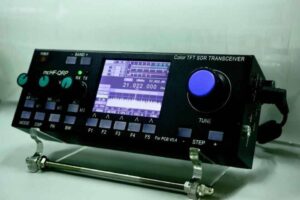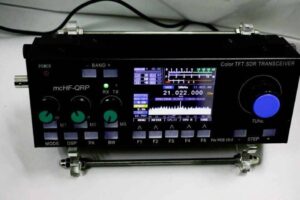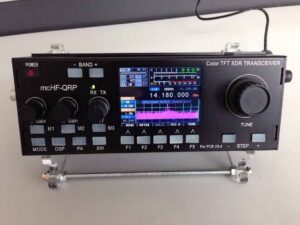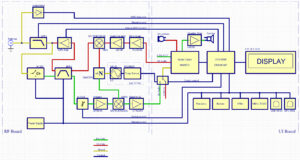

The choice of architecture is a direct conversion receiver and transmitter, with a small micro-controller to provide control and DSP functions. The analog

blocks in this implementation were kept to the bare minimum. Shifting, as much as possible, functionality into the digital domain.
The receiver features: a SN74CBT3253C Tayloe detector as a direct conversion mixer – Local Oscillator frequency is four times higher than the receive frequency; a digitally switched band pass filter; voltage controlled attenuator and pre-amp situated in the RF signal path before the actual direct conversion process. The resulting IQ audio signals from the detector are sent to the WM8731 Codec for conversion to digital data, and then via I2S bus to the STM32F4 controller. The decoding of the different modes (SSB,AM and CW) is then performed by DSP routines inside the CPU. Finally, processed audio is sent back to the CODEC chip and outputted via the speaker or LINE OUT output.
The transmitter uses a reverse process of mixing four channels of audio data with the LO signal. The result is amplified by the linear amplifier and passed via digitally switched LPFs into the antenna output. As with the receiver, the CODEC processes audio from a microphone or LINE IN to convert it to digital data where it is sent on to the CPU for DSP processing. Here IQ data is generated and sent back to the CODEC. When in CW mode, software defined DDS is used to generate side-tone, controlled by an iambic keyer. Resulting IQ data is sent in the same way to the CODEC for conversion to analog signals and passed on to the tx mixer.

- sensor on the I2C bus, attached physically to the local oscillator(SI570). Small tcxo routine in the firmware can help improve the frequency stability for digital modes
The architecture so far is no different than similar direct co
- nversion QRP kits and projects. I have tried to further ‘digitise’ the design and add some ideas which might prove to be useful over time:
- Temperature
- Voltage controlled physical attenuator in front of the RF pre-amp, controlled by the CPU built in DAC, hopefully providing better control over strong signals
- Digitally controlled BIAS for the final linear amplifier – simple PTT control, and no need for unreliable analog trimmer pots
- LPF switching via latch relays – lower power consumption avoiding thermal strain on the contacts
- Keypad with each button connected to separate GPIO pin instead of scanning matrix keyboard – lower noise and intermodulation products
- Single CPU clock of 16Mhz, well outside of ham bands for the fundamental and harmonics, TCXO with high stability
- CODEC main clock provided by the CPU PLL, high stability, very suitable for digital modes
- Constant LCD brightness, to avoid using TIMER PWM output, another way to avoid stray interference from the CPU to sensitive RF parts
- And finally simple power on/power off circuit, fully soft controlled, virtually no current draw when the transceiver is off
Price (In China) ~ $150 USD – Free shipping
FedEx IP takes only three days, from China to the United States; only need 4 days from China to the United Kingdom.
Please note that this is just a shell price, shell. (Stent complimentary)
If you are interested, please contact:
Mr. LI LE / BG8HSN
Yangjiaping, Jiulongpo District,
Chongqing City, China 400050 in China.
or by Facebook: https://www.facebook.com/BG8HSN
